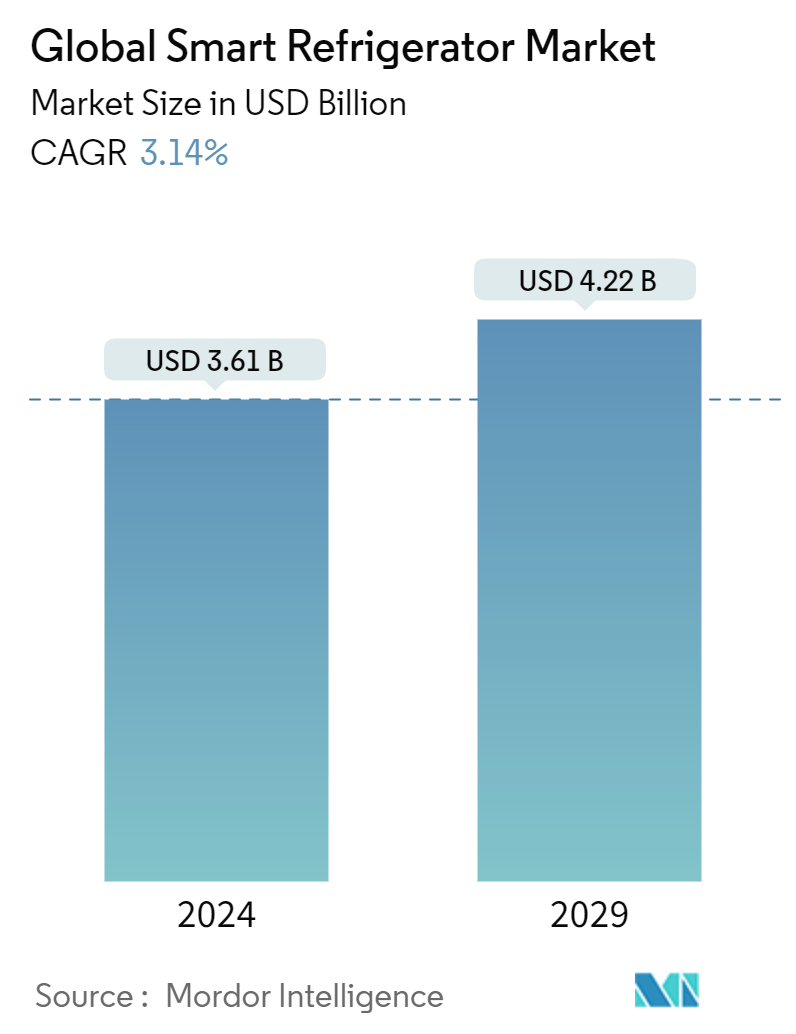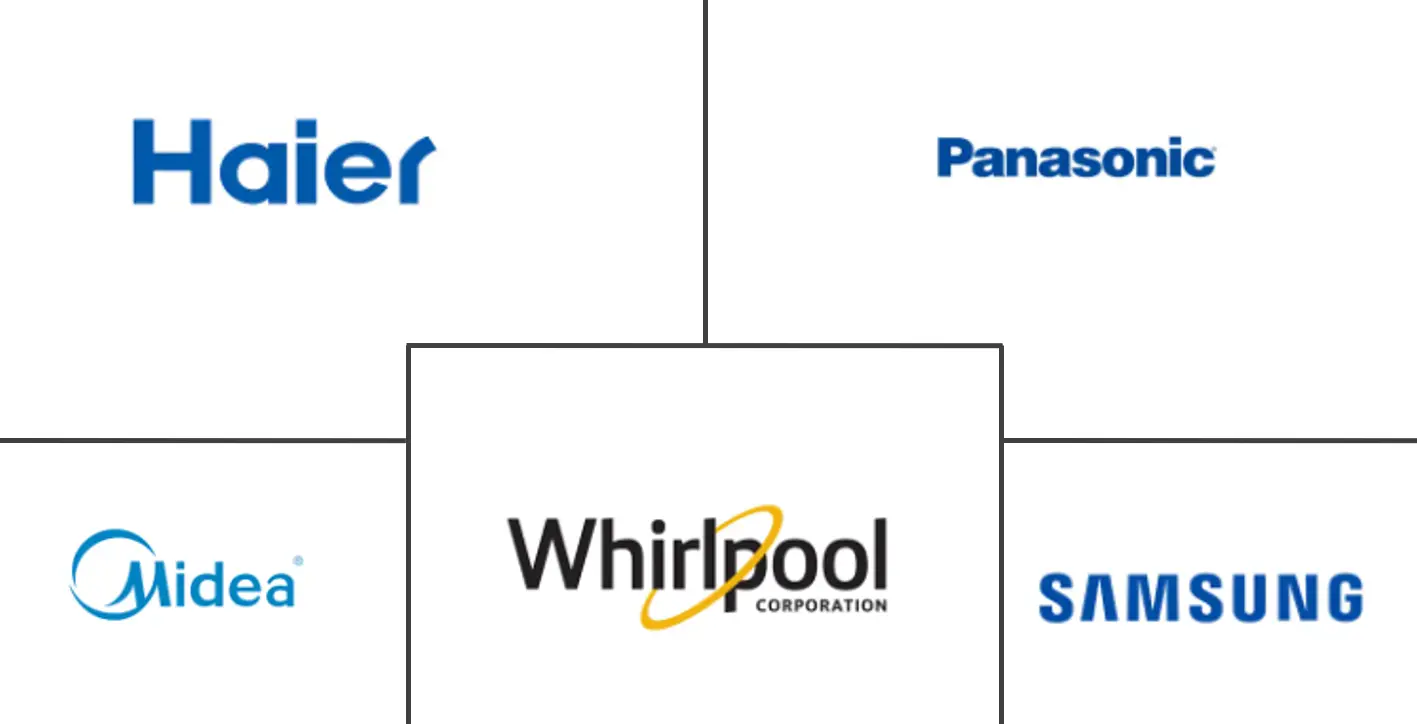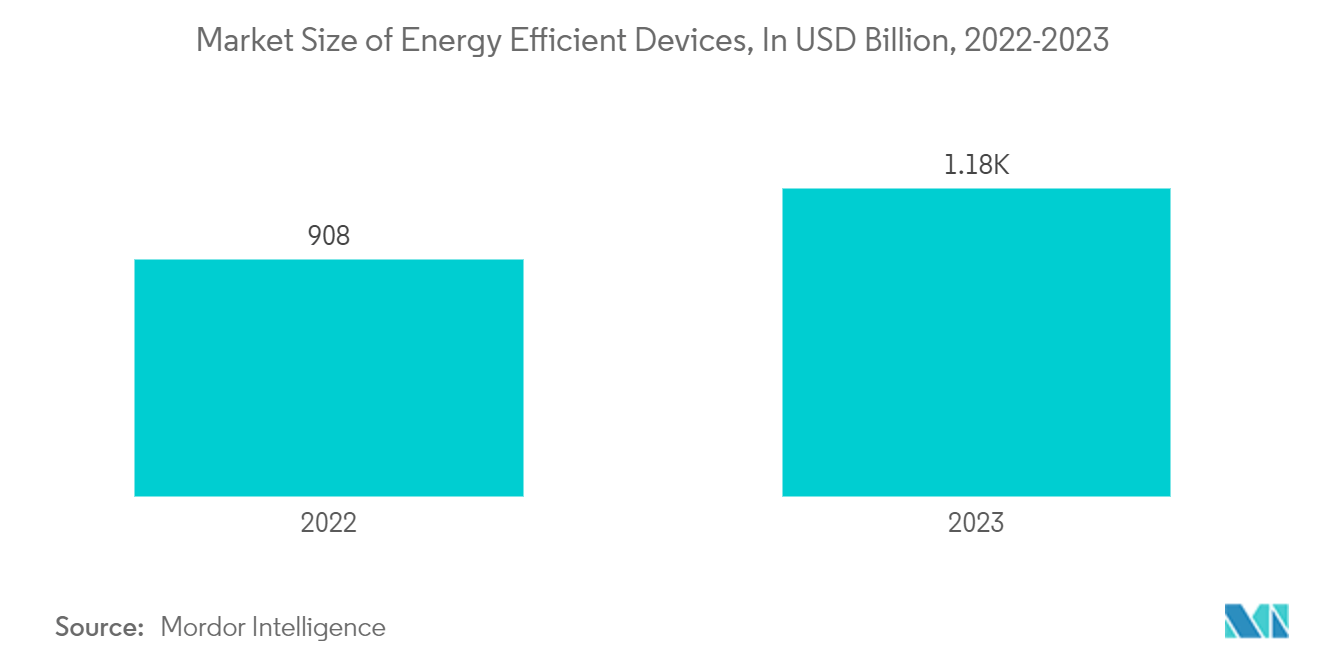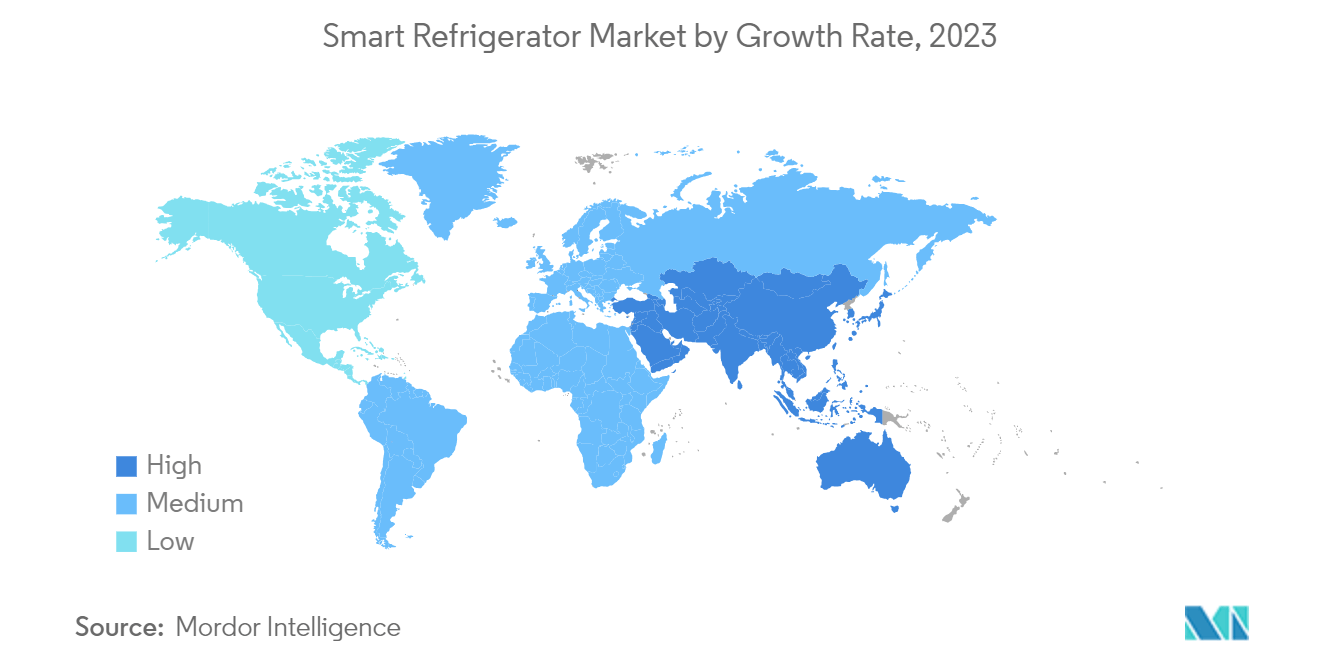Smart Refrigerator Market Size

| Study Period | 2020 - 2029 |
| Market Size (2024) | USD 3.61 Billion |
| Market Size (2029) | USD 4.22 Billion |
| CAGR (2024 - 2029) | 3.14 % |
| Fastest Growing Market | Asia-Pacific |
| Largest Market | North America |
Major Players
*Disclaimer: Major Players sorted in no particular order |
Smart Refrigerator Market Analysis
The Global Smart Refrigerator Market size is estimated at USD 3.61 billion in 2024, and is expected to reach USD 4.22 billion by 2029, growing at a CAGR of 3.14% during the forecast period (2024-2029).
One of the main drivers of the global smart fridge market is the growing need for convenience and connectivity among consumers. The commercial sector stands out as one of the most rapidly expanding segments within the global smart refrigeration market. Smart refrigerators are gaining traction in commercial environments like restaurants, hotels, and grocery stores due to their capacity to enhance food storage efficiency, decrease energy expenditures, and streamline inventory management processes. As businesses in the commercial sector strive to enhance food safety standards, minimize energy usage, and embrace sustainability practices, they are fueling the demand for smart refrigeration solutions and propelling market growth.
Urbanization and the demands of a hectic lifestyle are driving the growth of the market. There is also a growing awareness of environmental concerns and sustainability, which is driving the demand for environmentally friendly and green dry-cleaning solutions that use fewer toxic chemicals and processes, but environmental regulations and labour costs are expected to limit market growth.
Consumers are increasingly looking for ways to track and manage their diet, and smart refrigerators are at the forefront of this trend. They use technologies like cameras and sensors to identify foods, keep track of how fresh they are, and offer nutritional information. As individuals seek methods to uphold a healthy lifestyle, the popularity of smart refrigerators is on the rise. Lifestyle changes, time constraints, and long hours have also increased the need for smart fridge appliances that save time and can keep track of fridge contents daily. Frozen foods and ready to cook items are also growing in popularity.
Smart Refrigerator Market Trends
Rising Demand For Energy Efficient Refrigerators Driving the Market
Smart refrigerator makers are working quickly to make models that use less energy so they can reduce their carbon footprint and save consumers money on their energy bills.The rise of energy-efficient appliances can be traced to both government rules about electric home appliances and advances in technology.Energy-efficient appliances are made to do their job with the least amount of energy possible.Over 80 countries already have energy-efficient appliance regulations and labeling.
As food retailers look to reduce energy bills, every incremental savings counts. Increasing price competition means operating costs have an immediate impact on competitiveness and profitability-and, after staff, energy is the biggest bill most supermarkets have. In food retail, most of that energy is spent on refrigeration, so efficient new components, like the AKVP electric expansion valve and high-end case controllers, are usually a good investment.
The introduction of smart appliances that utilize IoT is reshaping the smart appliance industry.In the past few years, there have been a number of improvements to smart refrigerators, which have made them better at being sustainable.
In terms of retail value, Asia had the largest retail value of refrigerator appliances in 2022, followed by North America and Europe.

Asia Pacific Region Driving The Market
The Asia-Pacific market is expected to expand at the fastest rate over the forecast period, as smart connected refrigerator machines have gained popularity owing to their compatibility and user-friendliness features. Furthermore, the market expansion is fueled by rising urbanization and an expanding middle-class population. The presence of important market participants in the region also helps to support the development of innovative products to expand the customer base.
Product demand in this region is expected to be fueled by rising internet penetration and technological improvements in developing economies such as China and India. In India, the average rate of IoT penetration is in the single digits, whereas the global average rate is in the double digits. This creates a huge opportunity for the smart refrigerator machine industry to flourish in Asia Pacific's growing economies.
The Asia-Pacific region has the most price-sensitive customers, forcing companies to use promotional techniques like Black Friday specials, holiday sales, and additional online deals to boost sales of smart refrigerators.

Smart Refrigerator Industry Overview
This market has many companies fragmented over minor shares. Companies are focusing on expanding their product lines through product innovation, particularly in developing economies, to meet the rising demand. Some of the major players in the smart refrigerator market are Samsung, LG Electronics, Whirlpool Corporation, Haier Group, Robert Bosch GmbH, Siemens AG, GE Appliances, AB Electrolux, Panasonic Corporation, and others.
Smart Refrigerator Market Leaders
-
Whirlpool Corporation
-
Samsung
-
Haier
-
Electrolux
-
Panasonic
*Disclaimer: Major Players sorted in no particular order

Smart Refrigerator Market News
- January 2023: To strengthen its refrigerator manufacturing capacity, LG Electronics India invested INR 200 crore in its Pune unit. This investment is made towards setting up a manufacturing line and strengthening the company's local operation.
- December 2022: Smart Care, which exists as a portfolio company of Wind Point Partners, acquires Refrigeration Anytime LLC, a commercial refrigeration and HVAC equipment repair company in Chicago. The addition of Refrigeration Anytime will strengthen Smart Care's presence in Texas.
Smart Refrigerator Market Report - Table of Contents
1. INTRODUCTION
- 1.1 Study Assumptions and Market Definition
- 1.2 Scope of the Study
2. RESEARCH METHODOLOGY
3. EXECUTIVE SUMMARY
4. MARKET DYNAMICS AND INSIGHTS
- 4.1 Market Overview
- 4.2 Market Drivers
- 4.3 Market Restraints
- 4.4 Industry Value Chain Analysis
-
4.5 Industry Attractiveness - Porter's Five Forces Analysis
- 4.5.1 Bargaining Power of Buyers
- 4.5.2 Bargaining Power of Suppliers
- 4.5.3 Threat of New Entrants
- 4.5.4 Threat of Substitutes
- 4.5.5 Intensity of Competitive Rivalry
- 4.6 Insights of Technology Innovations in the Market
- 4.7 Impact of COVID-19 on the Market
5. MARKET SEGMENTATION
-
5.1 By Type
- 5.1.1 French Doors
- 5.1.2 Side-by-Side Doors
- 5.1.3 Triple Doors
- 5.1.4 Double Doors
- 5.1.5 Single Door
-
5.2 By End-Users
- 5.2.1 Residential
- 5.2.2 Commercial
-
5.3 By Geography
- 5.3.1 North America
- 5.3.2 South America
- 5.3.3 Europe
- 5.3.4 Asia Pasific
- 5.3.5 Middle East and Africa
6. COMPETITIVE LANDSCAPE
- 6.1 Market Concentration Overview
-
6.2 Company Profiles
- 6.2.1 Whirlpool
- 6.2.2 Samsung
- 6.2.3 Haier
- 6.2.4 Electrolux
- 6.2.5 LG
- 6.2.6 Panasonic
- 6.2.7 Robert Bosch GmbH
- 6.2.8 Siemens AG
- 6.2.9 General Electric Co.
- 6.2.10 Midea*
- *List Not Exhaustive
7. MARKET OPPORTUNITIES AND FUTURE TRENDS
8. DISCLAIMER AND ABOUT US
** Subject To AvailablitySmart Refrigerator Industry Segmentation
A smart refrigerator is a device that is connected to the cloud. These refrigerators are programmed to sense what kind of products are being stored inside. Depending on the configuration, it allows the use of smartphones to monitor and control the refrigerator. Apart from this, it also allows sending and receiving notes and calendar entries that appear on the refrigerator screen.
The smart refrigerator market is segmented by types, end-users, and geography. By types, the market is sub-segmented into French doors, side-by-side doors, triple doors, double doors, and single doors. By end-user, the market is sub-segmented into residential and commercial. By geography, the market is sub-segmented into North America, South America, Asia Pacific, Europe, and the Middle East and Africa.
The report offers market size and forecasts for the smart refrigerator market in terms of volume (number of products) and value (USD) for all the above segments.
| By Type | French Doors |
| Side-by-Side Doors | |
| Triple Doors | |
| Double Doors | |
| Single Door | |
| By End-Users | Residential |
| Commercial | |
| By Geography | North America |
| South America | |
| Europe | |
| Asia Pasific | |
| Middle East and Africa |
Smart Refrigerator Market Research FAQs
How big is the Global Smart Refrigerator Market?
The Global Smart Refrigerator Market size is expected to reach USD 3.61 billion in 2024 and grow at a CAGR of 3.14% to reach USD 4.22 billion by 2029.
What is the current Global Smart Refrigerator Market size?
In 2024, the Global Smart Refrigerator Market size is expected to reach USD 3.61 billion.
Who are the key players in Global Smart Refrigerator Market?
Whirlpool Corporation, Samsung, Haier, Electrolux and Panasonic are the major companies operating in the Global Smart Refrigerator Market.
Which is the fastest growing region in Global Smart Refrigerator Market?
Asia-Pacific is estimated to grow at the highest CAGR over the forecast period (2024-2029).
Which region has the biggest share in Global Smart Refrigerator Market?
In 2024, the North America accounts for the largest market share in Global Smart Refrigerator Market.
What years does this Global Smart Refrigerator Market cover, and what was the market size in 2023?
In 2023, the Global Smart Refrigerator Market size was estimated at USD 3.50 billion. The report covers the Global Smart Refrigerator Market historical market size for years: 2020, 2021, 2022 and 2023. The report also forecasts the Global Smart Refrigerator Market size for years: 2024, 2025, 2026, 2027, 2028 and 2029.
Smart Fridge Industry Report
Statistics for the 2024 Smart Fridge market share, size and revenue growth rate, created by Mordor Intelligence™ Industry Reports. Smart Fridge analysis includes a market forecast outlook to 2029 and historical overview. Get a sample of this industry analysis as a free report PDF download.



